MORAYS and other EELS
The Giant moray-eel (Gymnothorax javanicus)
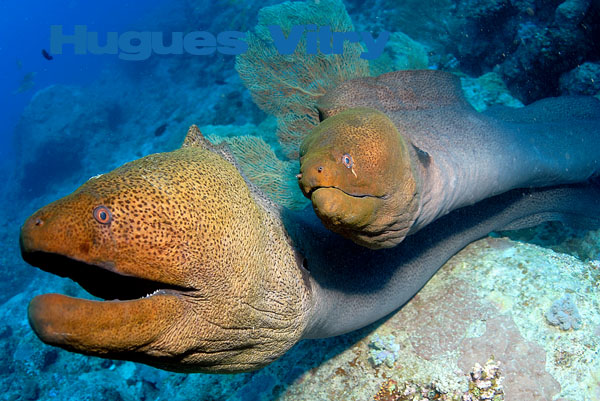
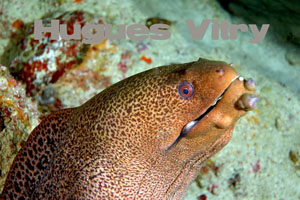
Morays can sometimes suffer from cancerous tumors
The Giant Moray is also known as the Java or Blackpearl Moray and locally as the “anguille lamandia” or “lamandian”.
Giant morays are among the biggest of the moray eels and can reach lengths of up to 3 meters.
Their coloring ranges from brown to black, often with greenish highlights on the head.
Their teeth are impressive, and as sharp as razors – they are capable of inflicting deep, serious lacerations.
Giant morays are more or less sedentary and territorial. Their territory can extend over hundreds of meters or even several kilometers
Although they can be dangerous, they allow themselves to be easily approached and may become familiar with human beings. However, it is strongly recommended that no attempt should be made to touch a moray during a dive. This should be left to divers who know the eels and who are recognized by them.
Giant morays can live to ages of over 25.
Giant morays are among the flagship species of your dives with Blue Water Diving Center!
Honeycomb Moray (Gymnothorax favagineus)
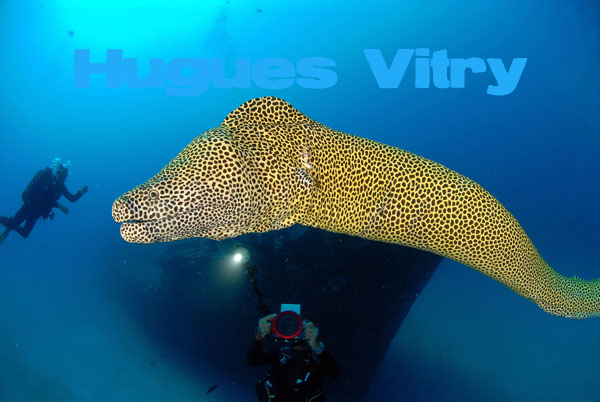
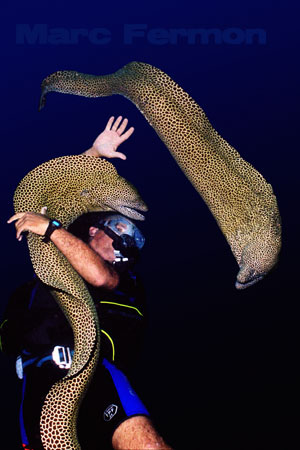
Like a sequence from the film “Dancing with Morays” 1999 (photo Marc Fermon)
Honeycomb morays are a sub-species of giant morays and are among the most beautiful of all morays.
As close relatives of the giant moray, honeycomb morays are as long and as substantial and there is a strong resemblance – with the exception of skin coloring. Maximum size is 3 meters.
Like giant morays, they feed mainly at night on fish and mollusks.
They are sedentary and territorial – fights between morays are extremely impressive.
The color inside a honeycomb moray’s mouth and its teeth is identical to that of its skin, which can give the impression that they have no teeth. However, the teeth of a honeycomb moray are as big and as sharp as those of a giant moray of the same overall size.
They are predated on by rays and sharks.
Over a period of years they easily become familiar with divers who visit regularly.
Hugues Vitry has a very special relationship with some of these morays.
Yellow-edged moray (Gymnothorax flavimarginatus)


As they get older, the heads of dark-spotted morays become darker
This is a common moray in Mauritius and it is encountered both inside and outside the lagoon. During the day they often hide away in cavities with cleaner shrimps.
At night they go out to hunt.
They will attack to defend against anything that comes near their hole. However, if they are attacked they may take the initiative, leaving their hole to inflict repeated, severe and deep bite wounds on the aggressor.
Such attacks occur at blinding speed and are inflicted deliberately on large animals, human beings included.
Leave absolutely alone!
Yellowmouth moray (Gymnothorax nudivome)
The yellowmouth, or starry, moray is a highly photogenic moray that allows you to approach with no sign of aggression.
Its maximum length is 1 meter.
Its body is light brown with white spots edged with brown.
The inside of the mouth is a deep, uniform yellow color.
It has strong, but barely visible, teeth.
It feeds on small fish and mollusks and often lives in cavities with cleaner shrimps.
To be left well alone!
Laced moray (Gymnothorax permistus)
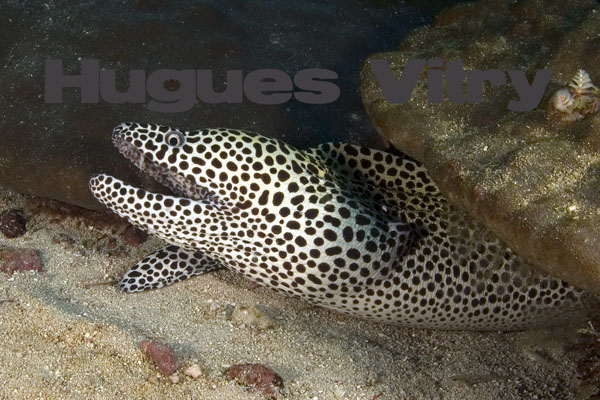
The laced moray closely resembles the juvenile honeycomb moray but is much smaller. Its adult size is rarely greater than 80 cm.
Like the honeycomb moray, its mouth is the same color as the skin and even the teeth are covered in a patterned film that makes them almost invisible.
It can be differentiated from the honeycomb moray in that its spots are dark brown against a light yellow background whereas the honeycomb moray has a yellow honeycomb pattern on a dark brown background.
Its teeth are highly developed and like all the Gymnothorax morays, it has a large tooth in the middle of its upper jaw.
It hunts mainly at night.
Also to be left alone.
Turkey moray (Gymnothorax meleagris)

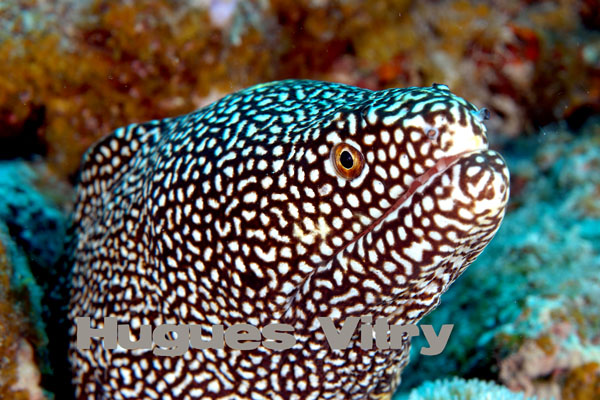
Other names for the turkey moray: guinea moray, spotted moray, whitemouth moray. It is very common on the inside and outside faces of the lagoon reef.
Its color can be quite light and the spots larger or smaller on a brown or black background.
Should not be confused with the rarer G. eurostus (Abbott’s moray).
Maximum size can exceed one meter.
They feed on small fish, mollusks and crustaceans.
To be left alone.
Abbott’s moray eel (Gymnothorax eurostus)
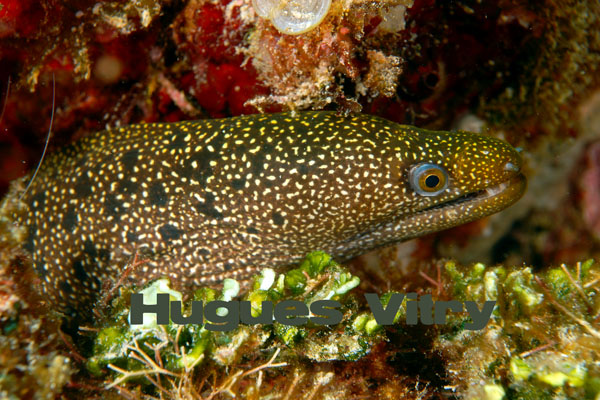
Juvenile form coloration
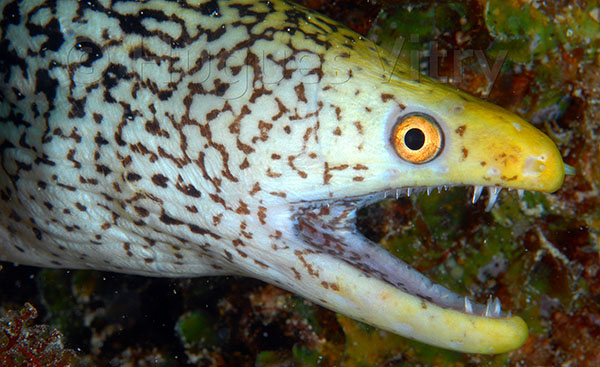
Adult form coloration
This moray is often confused with the turkey moray (G. meleagris) despite its different skin patterning.
This is a small moray that does not grow beyond 60cm. It is shy and lives hidden in cavities during the day, going out at night to feed.
Despite its small size, it is still capable of inflicting a deep bite wound.
Avoid putting your hand close to it or searching around inside cavities with your hand.
Viper moray (Enchelynassa canina)

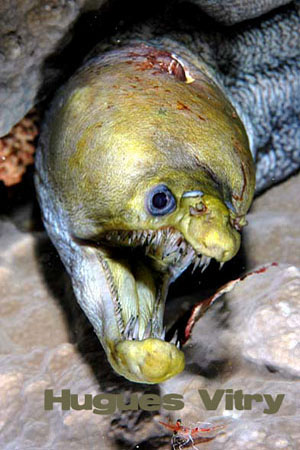
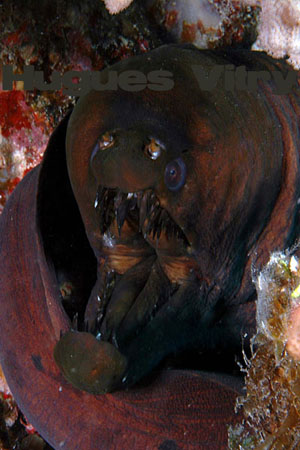
This is a fairly common type of moray in Mauritius. It is encountered both inside and outside the lagoon.
During the day they are often hidden away in cavities or in amongst robust branched coral growths. They emerge at night to hunt.
The viper moray’s coloring is dark brown in the daytime and lighter in tone at night.
They have large bulging eyes and a long snout.
The jaws cannot close completely due to the concave shape of the upper and lower jaws
The viper moray has one of the most impressive sets of teeth of any moray. They are large and sharp along the entire upper jaw and the front of the lower jaw but smaller and saw-edged towards the rear of the lower jaw.
The will attack in defense anything that approaches their den. However, if they are attacked they may take the initiative, leaving their hole to inflict repeated, severe and deep bite wounds on the aggressor.
Extremely dangerous!
Dragon moray (Enchelycore pardalis)

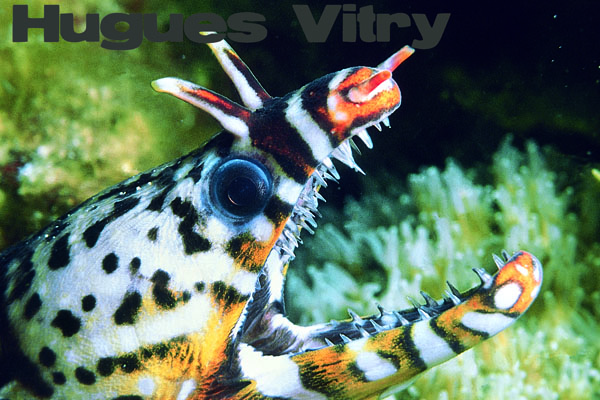
The dragon moray is undoubtedly the oceans’ most colorful moray.
It has two pairs of tubular excrescences in the form of horns: one very large pair stand straight up and the two others point forward from the nostrils.
Like the viper moray, the dragon moray has some highly impressive teeth and a large, narrow mouth incapable of closing completely.
The inside of its mouth is as colorful as its skin.
Young dragon morays have a less striking color scheme, and are darker with white markings.
Extremely dangerous.
Avoid entering its territorial space around the cavity where it lives.
Undulated moray (Gymnothorax undulatus)
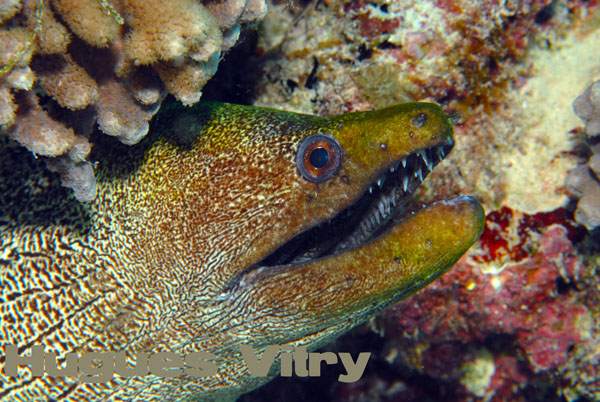
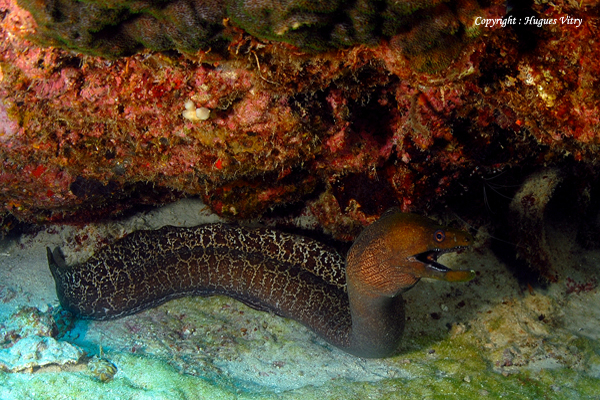
This is a moray with a green head and a tail with lighter bands.
It has large greenish blue eyes and an impressive mouth with sharp pointed teeth.
It can grow to over a meter in length.
It often cohabits with geometric morays.
<pstyle="text-align: justify;">Very active at night but can be an opportunistic predator during the day.
Highly aggressive.
To be left well alone; do not touch
Banded or yellow-headed moray (Gymnothorax rueppelliae)
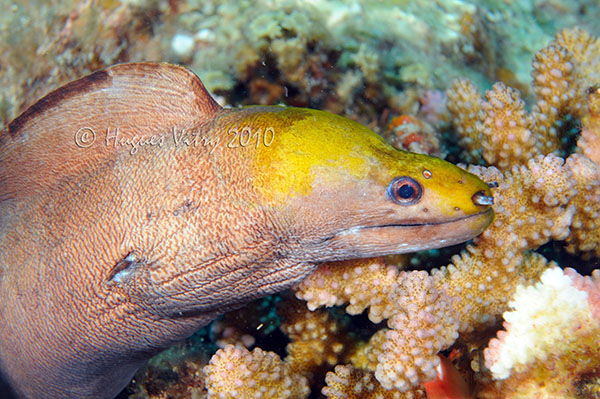
Uncommon in Mauritius, the yellow-headed or banded moray takes on a lighter coloring during the day and is darker toned at night (photos).
At night they can be confused with undulated morays.
Aggressive behavior when observed.
To be avoided.
Frimbriated moray (Gymnothorax fimbriatus)
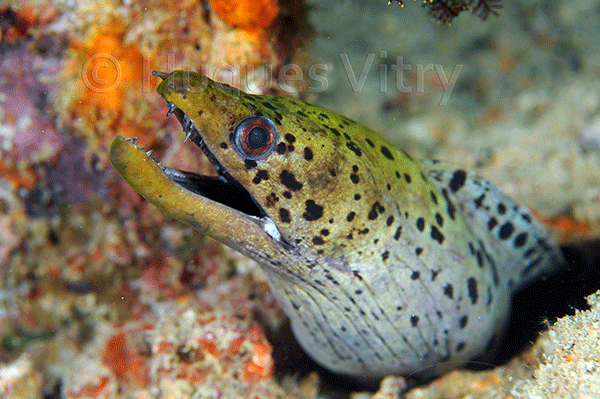

The fimbriated moray eel lives in inner and outer lagoon reefs. the are like most other morays night hunters and opportunists on day time. they can inflict severe bites if venture into their territories or if harassed. To avoid!
Barredfin moray (Gymnothorax zonipectis)
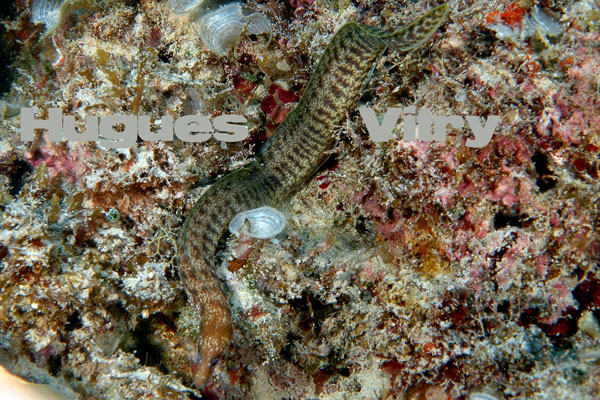
This is a small moray (50-70cm). It is quite shy and stays in its den, sometimes with morays of other species.
It has light colored blotches edged with brown on its lower jaw.
It is very rarely seen during the day.
Blotch-necked moray (Gymnothorax margaritophorus)
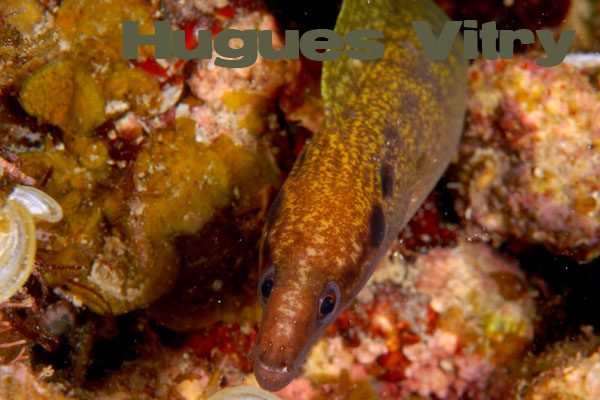
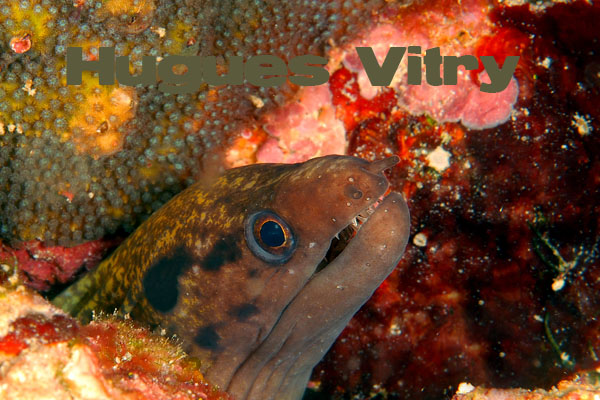
The blotch-necked moray is lively but shy during the day.
It grows no larger than 70cm and is 35cm long on average.
Hides away to a large extent and is rarely encountered. It lives on the forereef, on the outer slope down to a depth of 20m.
Can inflict bite wounds if you put your hand too near its hole.
Dwarf moray or dirty-yellow moray (Gymnothorax melatremus)
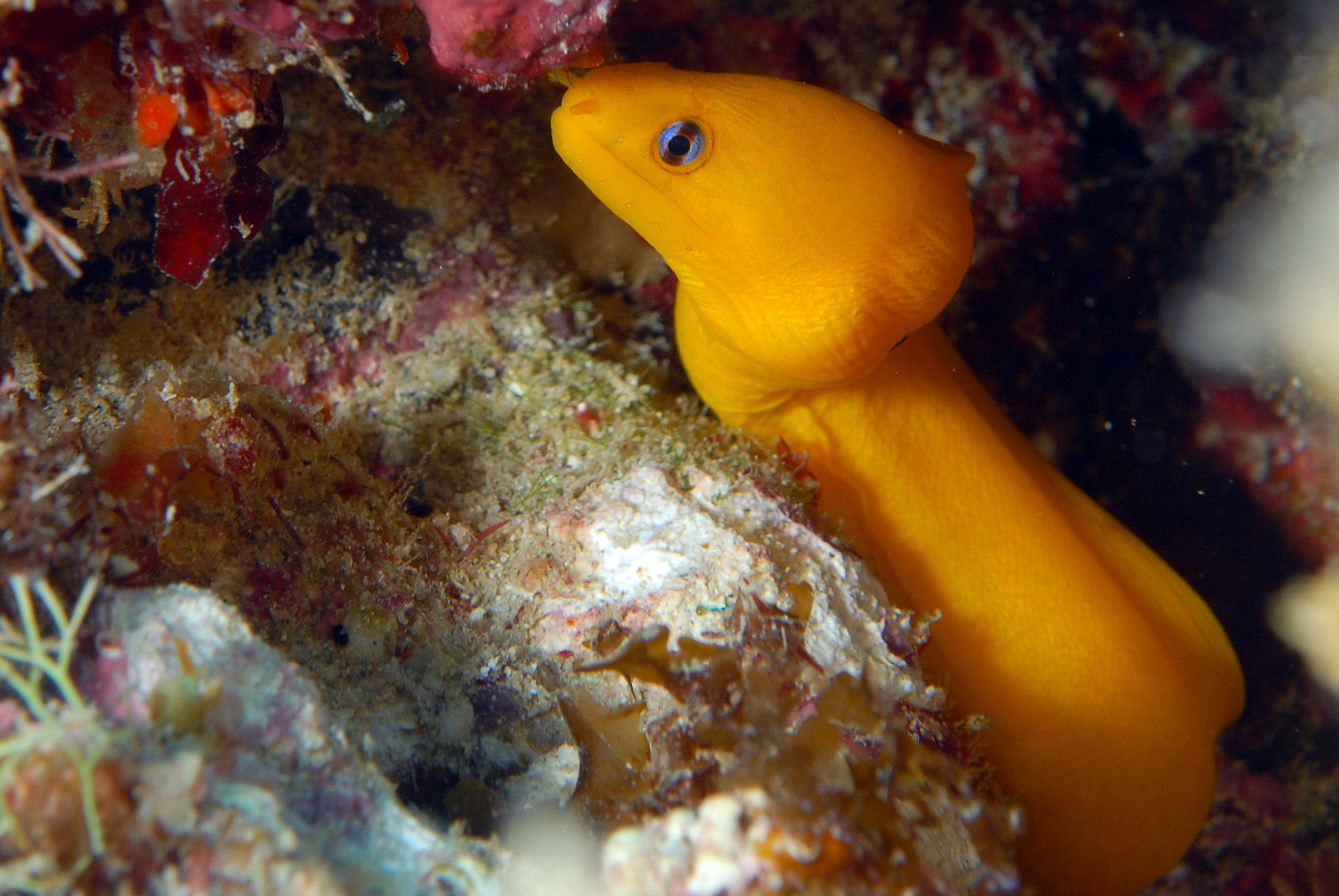

This is a small moray that is common but very rarely observed due to the fact that it remains hidden throughout the day and is difficult to see even at night.
Its size does not exceed 30cm.
Brown moray (Gymnothorax unicolor)
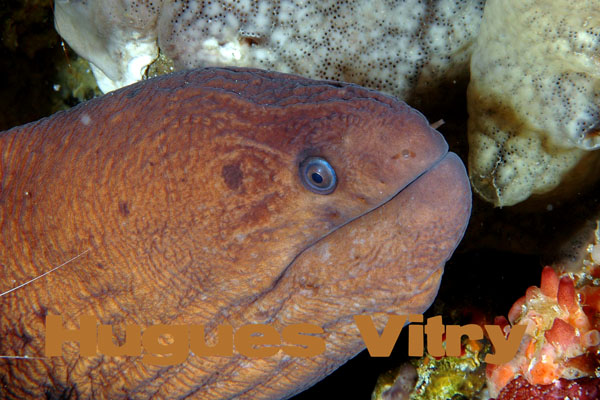
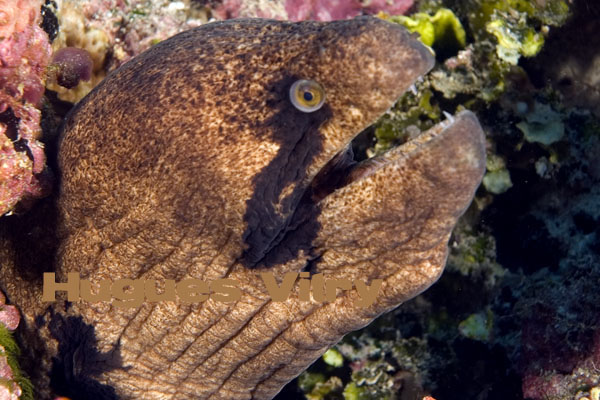
A masked moray not present in Mauritian waters.
This species of moray resembles, in terms of its morphology and behavior, Gymnothorax breedeni the masked, or blackcheek moray, which is not present in our waters (see photo 2).
The moray in the photo above lives in cavities on underwater walls from a depth of 35m downwards and are numerous in a given area. Like the masked moray (see photo) it is aggressive when its cavity is approached too closely. It will push out and draw back its head rapidly, opening its mouth.
It often lives with a number of species of cleaner shrimp and small fusiliers or pink-orange and silver sea perch. These take refuge in the cavities of the morays in large numbers when trevallies or other predators approach.
This moray has an orange brown coloration with a few scattered darker brown patches on its body. Its head is fairly massive. Like the masked moray, the mouth is symmetrically positioned in the middle of the two jaws which have the same height, unlike other species of moray which have a lower jaw that is thinner than the upper.
Vagrant or latticetail moray (Gymnothorax buroensis)
NO PHOTO AVAILABLE
Resembles the undulated moray ( G. undulatus) and it is easy to mistake it for its cousin! Both morays live in the same environment and have approximately the same behavioral characteristics.
Although it is smaller than the undulated moray it is never longer than 35cm. It is brown at the front of the body with small dark spots from half-way along the body up to the fins, the tail being dark with white stripes.
Leave alone.
Geometric or gray moray (Siderea grisea)
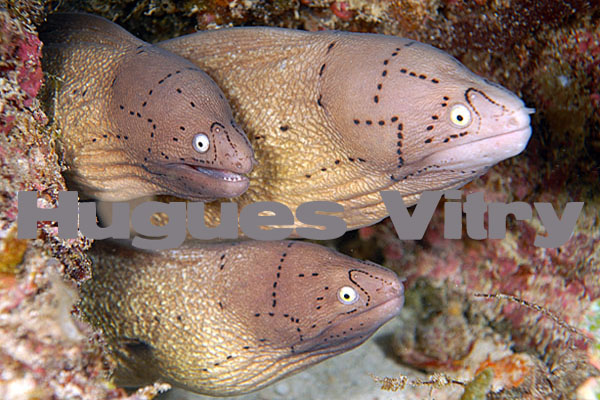
The most widely found species inside and outside the lagoon in Mauritius and throughout the Mascarene Islands.
This is a small, very curious moray whose size never exceeds 65cm.
Its body color is a light beige with a pinkish head with tiny dotted patterns on the snout resembling tattoos, hence its name in French: the “tattooed” moray.
Its eyes are white, which has given it the local nickname of “ghost” moray.
Its teeth are small and conical, making them more suited to crushing that tearing.
Geometric morays may live in groups of several individuals in the same cavity or in sections of pipe, old tires or bottles on the sea bottom, as well as under human constructions.
They feed on small crustaceans and mollusks.
Its bite is not dangerous but it has inherited the reputation of the other morays.
Zebra moray (Gymnomurena zebra)
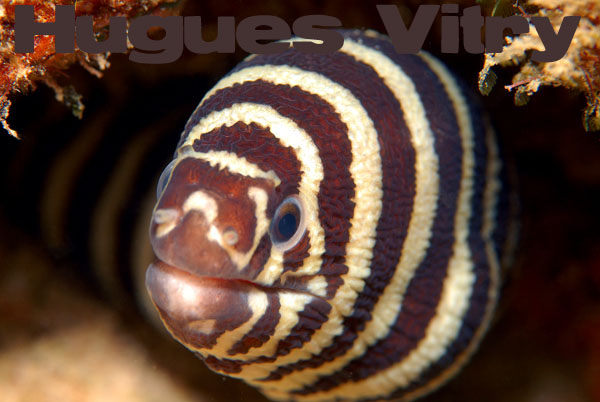
It is very shy and is rarely seen outside its den, in which it hides during the day.
Can be as long as 1.5m.
Feeds on young mollusks and crustaceans.
More active at night.
<pstyle="text-align: justify;">Its teeth are like those of the geometric moray – robust and conical in powerful jaws.
Leave well alone.
Snowflake moray (Echidna nebulosa)

A brown moray with light yellow stripes. Its fins are undeveloped.
A moray that is found very often under a rock in the surf zone near the beach.
Has small rounded, pointed teeth suitable for both crushing and tearing flesh.
May survive for several hours trapped in a puddle of water at temperatures exceeding 38ºC.
Feeds both at night and during the day.
Its bite is not dangerous but it has inherited the reputation of the other morays.
Tiger moray (Scuticaria tigrina)
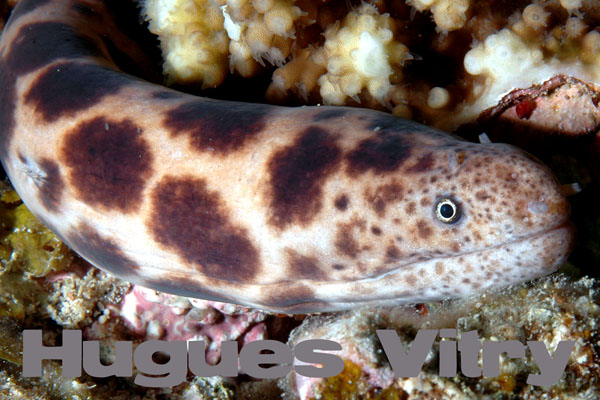
The tiger moray is uncommon.
It may reach a size of 1.2m.
It has a cylindrical body completely devoid of dorsal or anal fins, which prevents it from swimming. It creeps along the bottom in search of crustaceans and mollusks.
A timid moray.
Tiger reef eel (Scuticaria spp.)
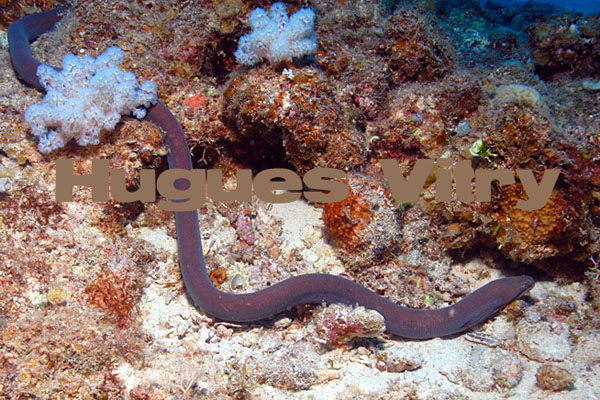
This moray, whose precise name we do not know, has a shape different from the tiger moray but its coloration is a uniform dark brown.
It has absolutely the same characteristics as the tiger moray and may be a different form of the same species.
From a distance, if it does not move, the observer has the impression that it is a piece of hosepipe lying on the bottom.
Channomuraena vittata (large mouthed moray)
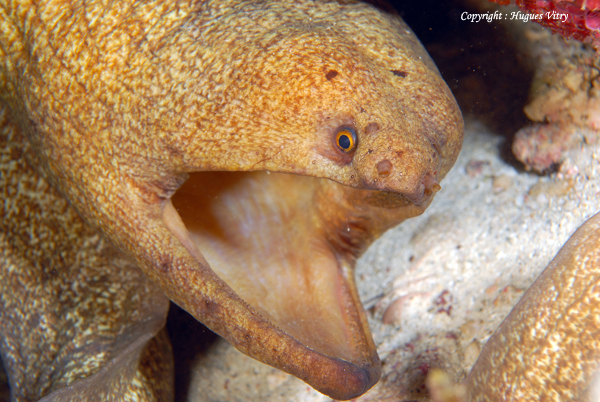
This species of moray eel described in 1987 by Hugues Vitry was apparently still unknown to science. Photographs were sent to the Bishop's Museum in Honolulu for identification, but correspondence with Professor J. Randall at the time indicated that it might be a species that had never been described before. Randall indicated that it might be a species that has hitherto never been described.
The difficulty in identifying a specific species is that a well-preserved specimen must be dissected in the laboratory to define its specific characteristics.
There was absolutely no question of killing one of these animals simply to give it a name.
It is nevertheless clear that the species does not belong to the Gymnothorax family.
Its body is quite massive, beige or sometimes darker in colour with broad dark brown bands bordered by white all over the body.
The animal has no fins.
The head is large and compressed with deep-set eyes and a golden retina.
The snout is extremely short and triangular.
The mouth is surprisingly wide and armed with tiny teeth in several rows close together.
They are sometimes seen in pairs on small reefs about ten metres below the corals, in crevices and holes during the day and are found exposed on the reef at night.
Hugues Vitry has nicknamed it the Megamouth moray.
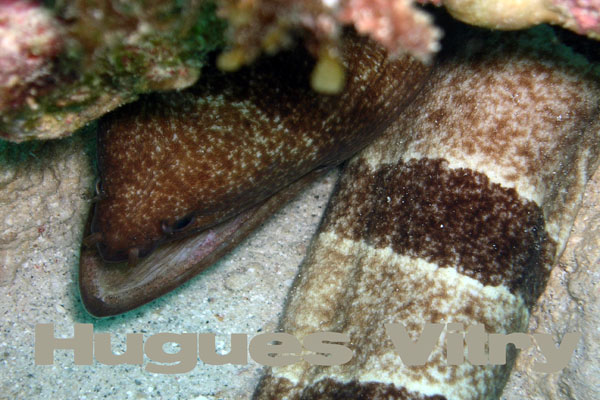
Barred moray (Echidna polyzona)
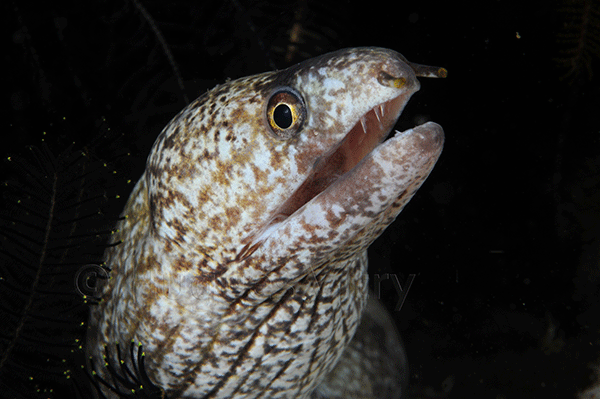
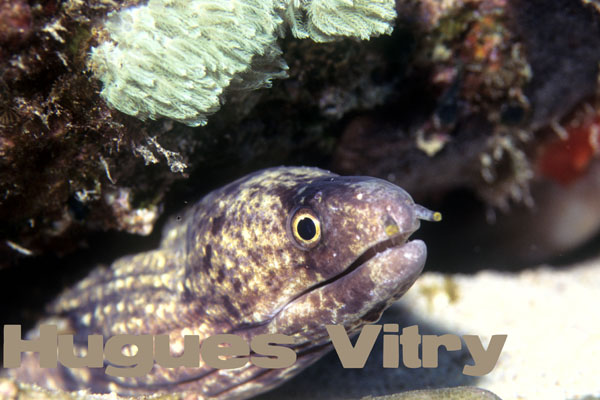
A beige-colored moray with dark yellow blotches and dark bands. Two large appendages with yellow orifices emerge from the nostrils. The eyes are large with a yellow retina.
It has a number of dark bands on its body.
Given the way in which it lies in wait, as other moray-eels it is an opportunistic predator during the day and hunt on the reef at night.
Ribbon moray (Rhinomuraena quaesita)
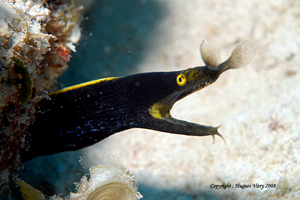

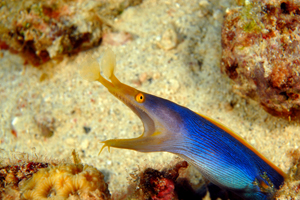
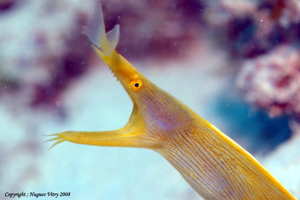
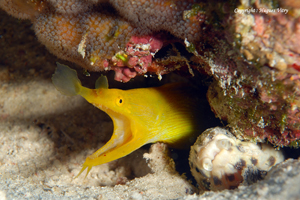

When young, this moray has an overall black coloring with yellow at the tip of its snout and on its dorsal and ventral fins. It then shifts to a uniform yellow via a very short stage in which it has a greenish tint. Finally, when it reaches the adult stage, it takes on a general electric blue coloring, keeping the same yellow coloring on the snout and fins.
It lives in a hole on the sea bottom and only its head and upper body emerge into the water where small or young fish are passing by. To attract its prey, this moray spends its time waving its head and horn-shaped nostrils and pointing the three barbels it has on its lower jaw. It is a fast, effective predator.
The feature that gives its common name – “ribbon” moray – is that it is extremely long (70 times its width) and when it is in open water outside its hole it swims on its side with its head up, looking like a Chinese ribbon.
Harlequin snake eel (Myrichthys colubrinus)

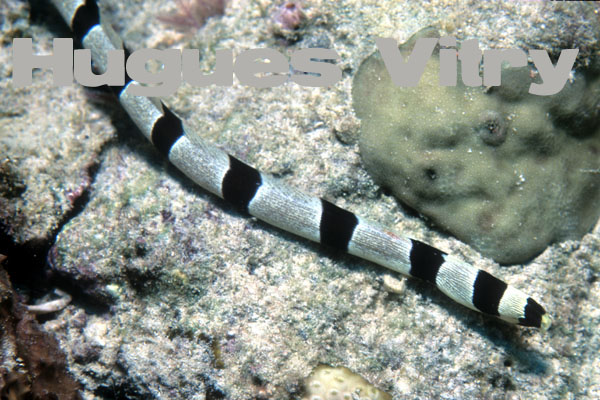
The Harlequin snake eel lives in shallow water in sandy areas of seagrass.
Its body has undeveloped pectoral fins plus dorsal and ventral fins.
In the face of danger it can burrow backwards under the sand, and then travel very quickly under the surface of the sand. It sometimes has just its head emerging from the sand in order to watch the surrounding area.
Maximum size 90cm.
Diet: small crustaceans and fish.
Is not dangerous to human beings despite its resemblance to a sea snake.
Spotted snake eel (Myrichthys maculosus)
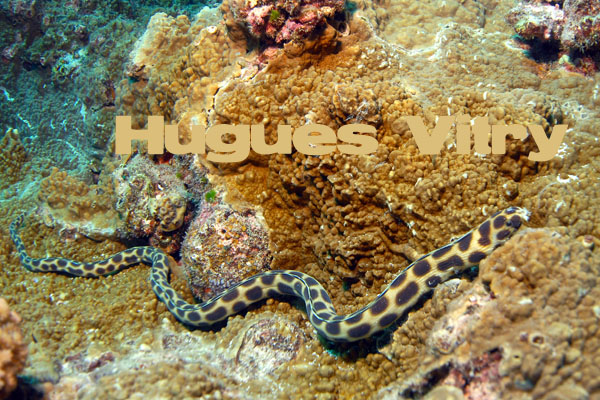
Spotted snake eels live in holes gravelly areas and spend their time looking for food in declining daylight.
A number of spotted snake eels may form a group in order to attack young octopuses and crustaceans, cleaner shrimps included.
They can be seen going down holes and once they have captured a prey they revolve rapidly to tear off pieces of flesh.
May reach up to a meter in length.
Not hazardous for human beings. Does not bite.
Marbled snake eel (Callechelys marmorata)
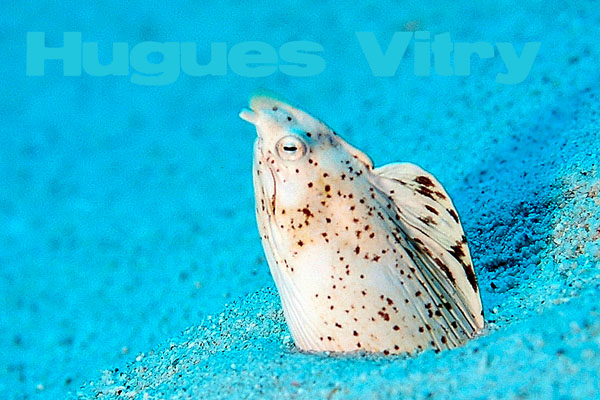
Lives in sandy areas and only rarely comes completely out of the sand. Immediately a danger presents itself, it burrows down into the sand, and moves away backwards under its surface.
They normally only leave their head out of the sand, opening and closing their mouth rapidly in order to breathe.
Feeds mainly at night on garden eels and also on small juvenile mollusks.
Can reach a length of 80cm.
Not hazardous for human beings.
Moustache conger (Conger cinereus)
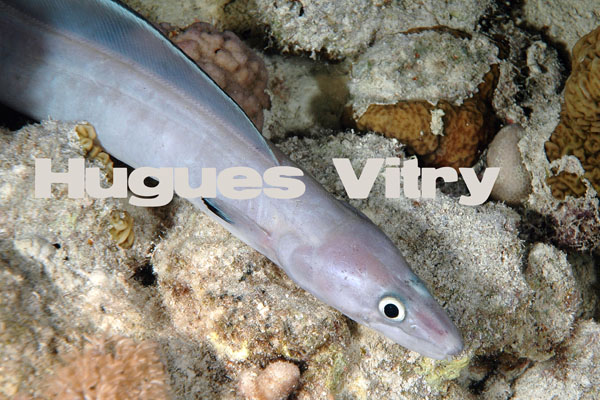
An eel that leaves its hiding place mainly at night and stays in darkness during the day. Sometimes during the night it takes on a coloration that includes broad darker bands over its whole body.
Feeds mainly on mollusks and crustaceans at night but is not averse to baby fish.
Can reach a length of 1.3 meters.
May bite.
Do not disturb.
Barred sand conger (Poeciloconger fasciatus)
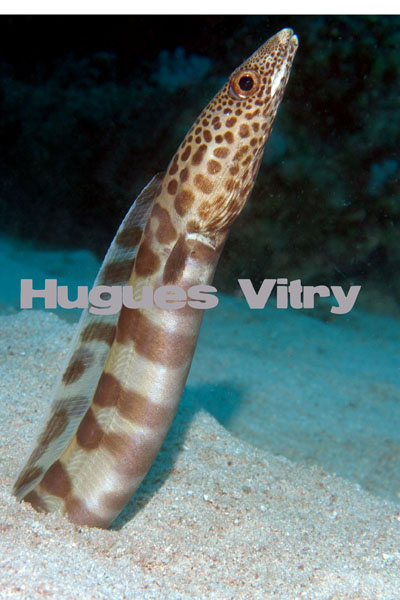
This sand conger is a golden gray color with dark bands along its whole body which change to smaller and smaller spots from the pectoral fins up to the snout.
It is often seen moving about on a sandy bottom but at the slightest sign of danger it will burrow backwards down into the sand.
It is not shy and may observe divers with its head just emerging from the sand.
Length: 60cm.
Napoleon snake eel (Ophychthus bonaparti)


This snake eel is light in color along its belly with a light beige back and large dark blotches. It has patterns reminiscent of snake scales on the top of its head.
Often its head alone emerges from the sand, which it will draw in before fleeing at high speed under the surface of the sand in the presence of danger.
Its worst predator is the dolphin.
It feeds on small crustaceans and mollusks, hunting mainly at night.
Not dangerous to human beings.
Spotted garden-eel (Heteroconger hassi)
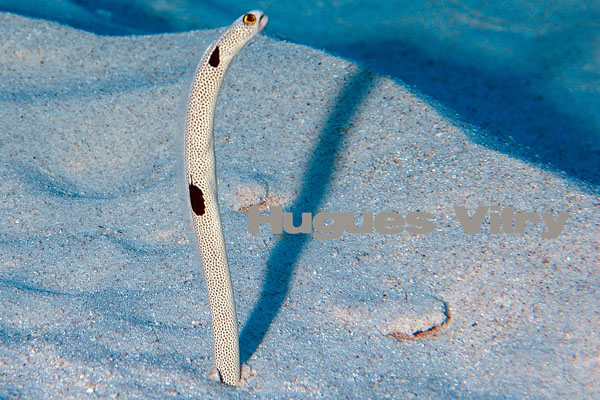
Garden eels should be called “Desjardins” (French for gardens) because this was the name of a naturalist who first described one of these heterocongers.
They live in colonies on plains of sand or mud from which a large part of their body length emerges in an undulating “S” shape, as they feed on plankton.
Immediately there is a sign of danger, they withdraw into the bottom, leaving just their eyes above its surface, withdrawing completely into a small hole if the danger continues to be present.
Its predators are dolphins and marbled snake eels.
Size: 60cm.
Unidentified morays
After intensive research on the web and in a number of manuals, it appears that we have many names of species but no photos or drawings to show how they look.
Hugues Vitry has added here a series of photos of morays taken in Mauritius for which he has been unable to find a name.
They are in some cases confused with the other species but they have different patterning on the head and body.
This one however looks very similar to the lipspot moray-eel (Gymnothorax chilospilus)
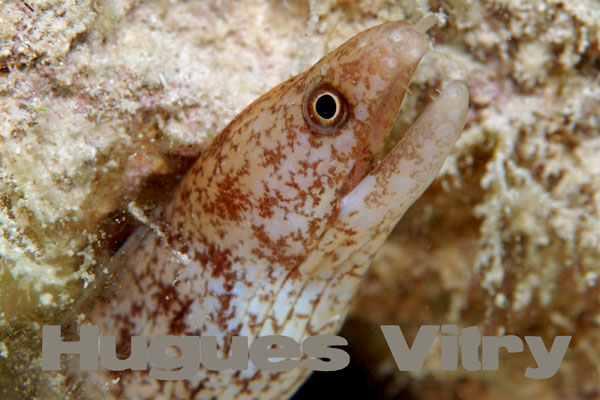
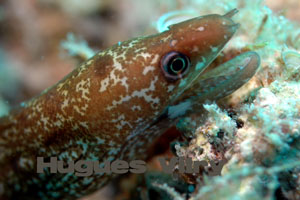

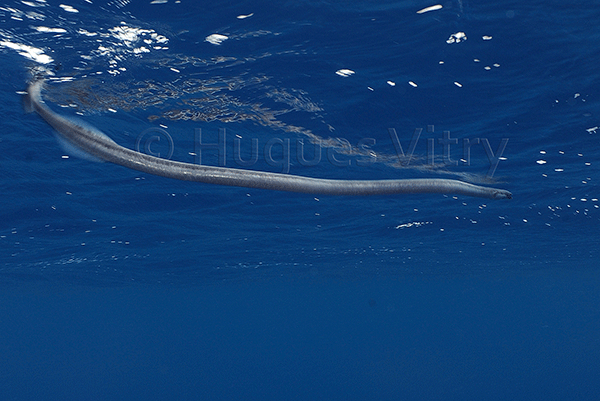
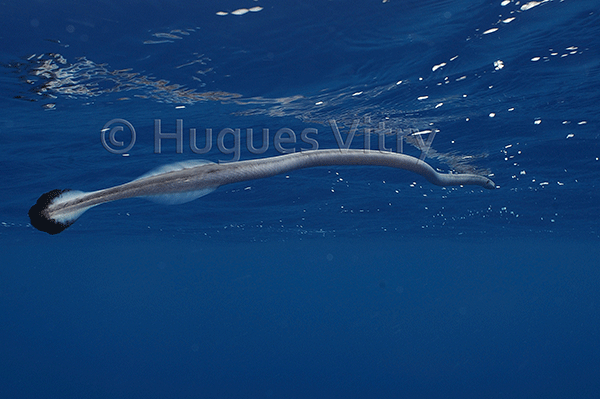
This species has been found swimming at the surface in the open sea. When it is brought to the bottom, it swims up to the surface.
The head is short and it has two very small pectoral fins which classify it in the anguilliformes family.
The body is about 80 cm long and almost cylindrical.
Its colour is overall silvery grey.
The fins are completely at the back and arranged as if it were an animal swimming in the water or on the surface.
I did not want to harass the animal to open its mouth to check its teeth.
I didn't have a lens to take close-ups of the head and every time we tried to get close, it would move away.
This species has only been encountered once offshore.
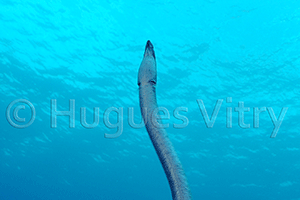


WARNING!
The photos on this page, like the photos on all the pages of this website, are the property of Hugues Vitry and Blue Water Diving Center. Any use of part or all of these images or articles is strictly prohibited unless written permission has been given.







